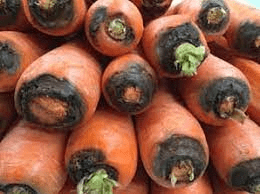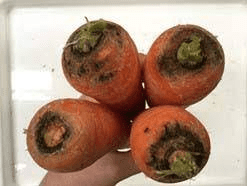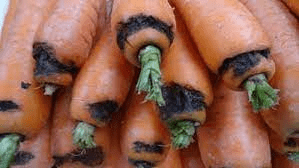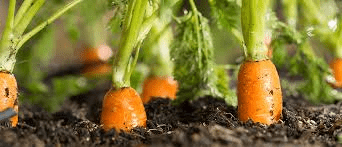The Carrot Crown is located at the soil surface, where the green foliage emerges and the root begins. This area is typically broader than the rest of the taproot and may exhibit a slight change in color, often a paler shade compared to the deeper orange of the root. The crown houses the meristematic tissues, which are regions of active cell division. These tissues are responsible for the growth of both the shoot and the root systems, making the crown essential for the plant’s vertical and lateral expansion.
Botanically, the crown functions as a storage site for carbohydrates. During the early stages of carrot development, the plant synthesizes and accumulates sugars in the crown, which are later translocated to the developing root. This storage capability is vital for the plant’s survival, particularly during periods of environmental stress such as drought or low nutrient availability. The crown acts as a buffer, ensuring that the plant has adequate energy reserves to support growth and reproduction.
The vascular system within the carrot crown is highly developed and complex, facilitating the efficient transport of water, nutrients, and photosynthates between the leaves and the root. The xylem and phloem vessels within the crown connect seamlessly with those in the root and shoots, enabling the bidirectional flow of essential substances. This connectivity is crucial for maintaining the physiological balance and overall health of the carrot plant.
In addition to its physiological functions, the crown plays a significant role in the plant’s defense mechanisms. The crown is often the first part of the root system exposed to potential pathogens or pests in the soil. As such, it is equipped with structural and chemical defenses. The outer layers of the crown are typically tougher and more lignified, providing a physical barrier against invasion. Additionally, the crown can produce secondary metabolites that deter herbivores and inhibit the growth of pathogens.
Agronomically, the health and integrity of the carrot crown are critical for successful cultivation. Farmers and horticulturists monitor the crown for signs of disease or pest infestation, which can compromise the entire plant. Common issues include crown rot, caused by fungal pathogens, and damage from soil-borne insects. Effective management practices, such as crop rotation, soil sterilization, and the use of resistant carrot varieties, are employed to protect the crown and ensure robust crop yields.
Understanding the biological and functional aspects of the carrot crown also has implications for post-harvest handling and storage. The crown is often trimmed during harvest to reduce moisture loss and prevent decay, which can extend the shelf life of carrots. Proper handling of the crown during processing helps maintain the quality and nutritional value of the harvested roots.
The carrot crown is a vital component of the carrot plant, contributing to its growth, nutrient allocation, and defense. It serves as a hub for the plant’s vascular system, facilitates carbohydrate storage, and provides structural defenses against environmental threats. Recognizing the importance of the crown in both agricultural practices and botanical studies can lead to improved cultivation techniques and enhanced crop productivity.
The Economic Importance and Uses of Carrot Crown

1. Crop Identification: Carrot crowns help in identifying the maturity and quality of the crop. Farmers assess the crown to determine if the carrots are ready for harvest.
2. Harvesting Efficiency: The condition of the carrot crown can indicate the best time for harvesting, ensuring maximum yield and quality.
3. Genetic Studies: Carrot crowns are used in genetic studies to improve carrot varieties, focusing on traits like disease resistance and growth efficiency.
4. Seed Production: The crown is crucial in the process of seed production, as it is the point from which new growth occurs after the root has matured.
5. Disease Resistance: Studying the carrot crown can help in understanding disease resistance, as it is often the first part affected by soil-borne pathogens.
6. Soil Health Indicator: The health of the carrot crown can indicate the quality of the soil and its suitability for future crops.
7. Organic Farming: Carrot crowns are important in organic farming practices, where understanding plant health and development is crucial for maintaining soil fertility.
8. Biochemical Studies: The carrot crown is studied for its biochemical properties, which can lead to the development of new nutritional supplements or pharmaceuticals.
9. Culinary Uses: While typically not consumed directly, the crown can be used in culinary applications for garnishes or to enhance the flavor of broths and soups.
10. Animal Feed: Carrot crowns can be used as a nutritious component of animal feed, particularly for livestock such as cattle and goats.
11. Composting: The crowns can be composted to create nutrient-rich soil amendments, promoting sustainable agricultural practices.
12. Bioplastics: Research is exploring the use of carrot crowns in the production of bioplastics, offering a sustainable alternative to traditional plastics.
13. Natural Dyes: Carrot crowns can be used to produce natural dyes for textiles and other materials.
14. Biofuel: The organic material from carrot crowns can be processed into biofuels, contributing to renewable energy sources.
15. Soil Erosion Control: Planting carrot crowns can help control soil erosion, as their root systems stabilize the soil.
16. Nutraceuticals: Extracts from carrot crowns are being studied for their potential health benefits and use in nutraceutical products.
17. Cosmetic Products: Compounds from carrot crowns can be used in cosmetic products for their potential skin benefits.
18. Educational Purposes: Carrot crowns are used in educational settings to teach about plant biology, growth, and development.
Read Also Complete List of Different Types of Cat Breeds
The Products and By-products That Can Be Derived From Carrot Crown

1. Natural Dyes: Carrot crowns can be processed to extract pigments used in natural dyes for textiles and other materials.
2. Biofuels: The organic material from carrot crowns can be converted into biofuels through fermentation and other processes.
3. Compost: Carrot crowns are excellent for composting, turning into nutrient-rich soil amendments that enhance soil fertility.
4. Animal Feed: Processed carrot crowns can be used as a nutritious addition to animal feed for livestock.
5. Bioplastics: Research is being conducted to utilize carrot crowns in the production of biodegradable plastics.
6. Nutritional Supplements: Extracts from carrot crowns can be used in the formulation of dietary supplements.
7. Cosmetics: Carrot crown extracts are used in skincare products for their potential antioxidant properties.
8. Fertilizers: Processed carrot crowns can be used to create organic fertilizers that improve soil health.
9. Pharmaceutical Ingredients: Compounds isolated from carrot crowns may be used in the development of pharmaceuticals.
10. Culinary Ingredients: Carrot crowns can be used in culinary applications to add flavor to broths, soups, and sauces.
11. Biochar: Carrot crowns can be converted into biochar, a carbon-rich product that enhances soil fertility and captures carbon.
12. Essential Oils: Carrot crowns can be distilled to produce essential oils used in aromatherapy and natural remedies.
13. Fiber Supplements: The fibrous material from carrot crowns can be used to create dietary fiber supplements.
14. Enzymes: Carrot crowns can be processed to extract enzymes used in various industrial applications.
15. Pesticides: Natural compounds from carrot crowns are being researched for their potential use in organic pesticides.
16. Pet Food: Processed carrot crowns can be included in pet food formulations to provide additional nutrients.
17. Decorative Crafts: Dried carrot crowns can be used in decorative crafts and floral arrangements.
Read Also Different Breeds of Goats and their Importance
Frequently Asked Questions (FAQ’s) About Carrot Crown

1. What is the carrot crown?
The carrot crown is the upper part of the carrot root where the leaves attach.
2. Can you eat the carrot crown?
While not typically consumed directly, the carrot crown can be used in broths and soups to add flavor.
3. How does the carrot crown affect harvesting?
The condition of the carrot crown helps farmers determine the best time to harvest for optimal yield and quality.
4. Are carrot crowns used in animal feed?
Yes, carrot crowns can be processed and included in livestock feed.
5. What products can be made from carrot crowns?
Carrot crowns can be used to make natural dyes, biofuels, compost, and more.
6. Can carrot crowns be composted?
Yes, carrot crowns are excellent for composting, adding valuable nutrients to the compost.
7. Are carrot crowns used in cosmetics?
Extracts from carrot crowns are used in some cosmetic products for their potential skin benefits.
8. How do carrot crowns contribute to soil health?
Carrot crowns can be composted or used as organic fertilizers to improve soil health and fertility.
9. What research is being done on carrot crowns?
Research is exploring the use of carrot crowns in bioplastics, biofuels, and pharmaceuticals.
10. Are carrot crowns used in educational settings?
Yes, carrot crowns are used to teach about plant biology, growth, and development.
Read Also How to Make Your Own Organic Pesticides

